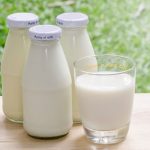 In 1818, Abraham Lincoln’s mother died of “the slows,” a disease caused by contaminated milk; four years later, Louis Pasteur was born, a French chemist who invented pasteurization, a process that made milk much safer to drink. As a result of pasteurization, milk ceased, in the nineteenth century, to be treated with suspicion and instead enjoyed an immense surge in popularity, a popularity ensured by the invention of the refrigerator. These two developments also led, in the 1880s, to the invention of an icy refreshment known as the milkshake. Several thousand years before this, the word milk began to evolve from an Indo-European word, pronounced something like melg, that meant to stroke. This word was first applied to the action of milking a cow or similar animal, since the teats of the animal’s udder are stroked downward to extract its milk. In time, this ancient word was applied to the nourishing liquid itself, at which point it entered various members of the Indo-European family of languages: in Old English, it became meolc, which evolved into milk by the thirteenth century; in Latin, it became the verb mulgere, meaning to milk, which eventually evolved into the word emulsify, meaning to turn into a milky substance.
In 1818, Abraham Lincoln’s mother died of “the slows,” a disease caused by contaminated milk; four years later, Louis Pasteur was born, a French chemist who invented pasteurization, a process that made milk much safer to drink. As a result of pasteurization, milk ceased, in the nineteenth century, to be treated with suspicion and instead enjoyed an immense surge in popularity, a popularity ensured by the invention of the refrigerator. These two developments also led, in the 1880s, to the invention of an icy refreshment known as the milkshake. Several thousand years before this, the word milk began to evolve from an Indo-European word, pronounced something like melg, that meant to stroke. This word was first applied to the action of milking a cow or similar animal, since the teats of the animal’s udder are stroked downward to extract its milk. In time, this ancient word was applied to the nourishing liquid itself, at which point it entered various members of the Indo-European family of languages: in Old English, it became meolc, which evolved into milk by the thirteenth century; in Latin, it became the verb mulgere, meaning to milk, which eventually evolved into the word emulsify, meaning to turn into a milky substance.
A white liquid produced by female mammals to feed their young. Cow’s milk and other dairy products are important parts of most diets, especially children’s.
The breast milk produced by a woman.
The nutritious fluid secreted by the mammary glands of mammals, breasts in humans and udders in many other mammals, such as cows or goats. Milk is made up of various nutrients, including protein, fats, carbohydrates (primarily lactose), and various vitamins and minerals. The proportion and kind of these nutrients varies somewhat between human milk and milk from other mammals. Human milk itself varies from person to person and even in the same person at different times of the day and stages of nursing or with varied diets. Human milk also has important antibodies to provide early immunization to infants during breastfeeding. In addition, it is quite digestible by most newborns, even those who a few months later will show signs of lactose intolerance, or inability to digest and absorb milk’s nutrients.
Fluid secreted by mammary glands (breasts), usually the first food of newborn mammals. Humans also consume the milk of cows and certain other mammals (e.g., goats, yak). Milk contains carbohydrates (lactose), protein (casein), fat, the minerals calcium and phosphorus, and vitamins A, riboflavin, niacin, thiamine, and, when fortified, D.
The liquid food secreted by female mammals from the mammary gland. It is the sole source of food for the young of most mammals at the start of life. Milk is a complete food in that it has most of the nutrients necessary for life: protein, carbohydrate, fat, minerals, and vitamins. The composition of milk varies very much from mammal to mammal. Cows milk contains nearly all the essential nutrients but is comparatively deficient in vitamins C and D. Human milk contains more sugar (lactose) and less protein than cows milk.
The natural food of all mammals for a considerable period following their birth. It is practically the only form of animal food in which protein, fat, carbohydrate and salt are all represented in sufficient amount, and therefore contains all the constituents of a standard diet.
A secretion of the mammary glands for the nourishment of the young.
Milk stands as an exceptional and comprehensive nourishment, ranking among the most wholesome foods available. Within a varied diet, its significance shines through as an abundant source of protein, calcium, and riboflavin. Its value is particularly noteworthy for various groups, including growing children, pregnant women, nursing mothers, and the elderly. For these individuals, milk plays a vital role in meeting their nutritional needs. The elderly, in particular, find it especially valuable as it provides essential nutrients without the need for extensive preparation, offering a convenient and accessible source of sustenance. Embrace the inherent richness of milk, recognizing its immense benefits for diverse stages of life and dietary requirements.
The pale fluid produced by the mammary glands to provide nourishment for the offspring.
Any pale, milk-like fluid, such as coconut milk.
A mixture of chemical substances, like milk of magnesia.
